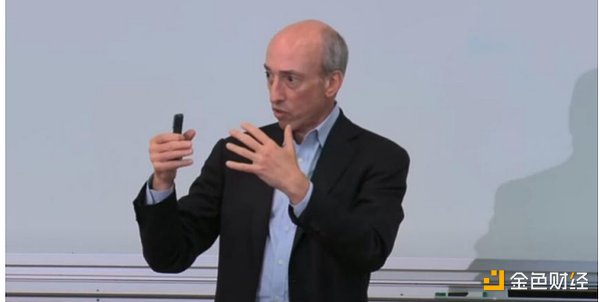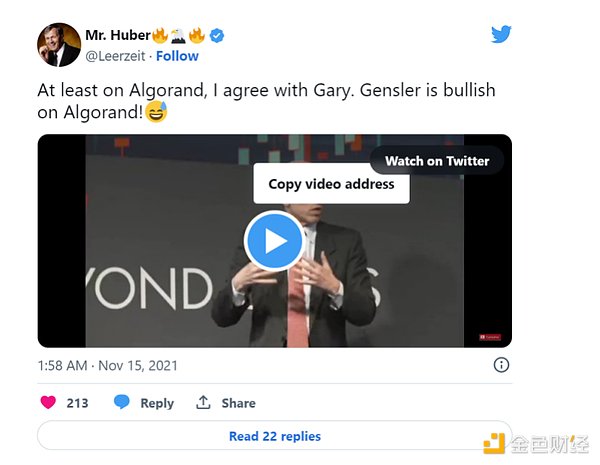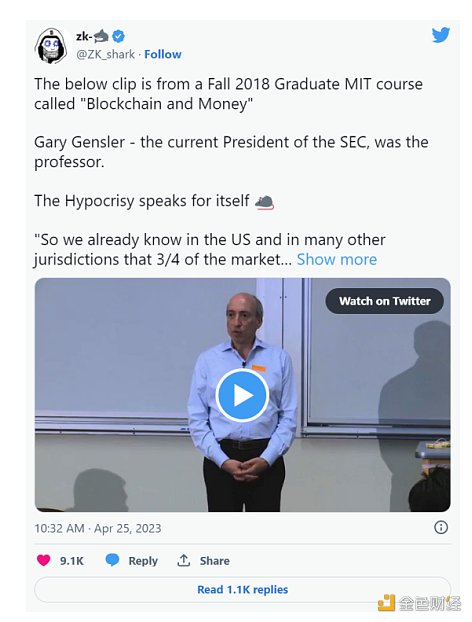Author: BitMEX Research, Translator: LianGuaixiaozou
Abstract:
In this article, we will compare the gold and precious metals trading community (gold investors) from 2009 to 2012 with today’s cryptocurrency community. We will pay particular attention to the role played by Gary Gensler, the Chairman of the U.S. Securities and Exchange Commission (SEC), and the similarities and controversies compared to 13 years ago. Both the passionate online communities at that time and today have some members who criticize Gensler’s regulatory measures as inappropriate and inconsistent. In addition, some people accuse him of failing to protect the interests of small investors and succumbing to the demands of established large financial institutions without fairness. Regardless of how you view Mr. Gensler, it is important not to forget his unique past experiences. Gensler has been through all this before, so he may be more able to adapt to current pressures than some people think.

- UniswapX Trading Mechanism Explained Building a Complex and Competitive Routing Network
- The Prototype of DeFi Super Application Analyzing the Aggregation Platform Instadapp.
- Why do people say ‘if someone can get approved for a BTC ETF, it will be BlackRock’?
1. Overview
Gary Gensler, the chairman of the SEC, is a prominent figure in the cryptocurrency field. He is almost at the center of everything, including regulatory actions against Coinbase and Binance, Bitcoin ETF applications, accounting rules that could prevent institutions from acting as cryptocurrency custodians, and a host of legal cases. Recently, the SEC’s activities have been key drivers of cryptocurrency prices, whether it is the downward momentum or the upward momentum after the SEC’s defeat in court. Some members of the cryptocurrency community are keen to oppose and ridicule Gensler, pointing out the logical fallacies, inconsistencies, and contradictions in Gensler’s positions. Crypto Twitter is full of memes about Gensler, and even Gensler coins have emerged. For some, Gensler is quickly becoming the biggest villain in the cryptocurrency space and is under intense scrutiny.
However, few young cryptocurrency enthusiasts today may know that Gary Gensler has been through all this before, at least to some extent. In the past, Gensler was also seen as an antagonist by another passionate and dedicated online community. The best candidate for the early Bitcoin movement was the speculative macro traders/gold investors/gold & precious metals traders community from 2009 to 2012. This group was not a friend of Gensler either.
Gensler, who previously worked at Goldman Sachs, is now the chairman of the SEC, but earlier, he held a very similar position at the Commodity Futures Trading Commission (CFTC). At that time, some people in the internet-driven gold & precious metals trading community also did not like Gensler. Like today, Gensler was repeatedly accused by an active and passionate community of inappropriate regulatory actions, failure to protect the interests of small players, and only benefiting large financial institutions.
2. History Does Not Repeat Itself, But It Often Rhymes
In the table below, we attempt to compare the situation between 2009 and 2012 with the current state of the cryptocurrency industry. While there are many key differences between the two periods, there are also some fascinating similarities. Of course, the most noteworthy is Gary Gensler, who played a remarkably similar and important role in both periods.
|
Gold & Precious Metal Traders |
Bitcoin & Cryptocurrency Traders |
|
|
Key Period |
2009-2012 |
2013-Present |
|
Core Narrative |
Inept bankers suffered heavy losses in the 2008 financial crisis. Subsequently, self-interested politicians used taxpayers’ money to bail out the bankers, exacerbating the imbalance, further entrenching crony capitalism and poor incentive mechanisms, and worsening the situation. The result of massive bailouts was an excessive public debt burden. The U.S. government was unable to repay its debt, leading to inflation. This is why people should invest in gold, as its value cannot be inflated by the government. |
Compared to precious metals, the positive narrative surrounding cryptocurrencies is more diverse. · Currency with a known supply, like Bitcoin, is superior to the U.S. dollar, which will depreciate due to unsustainable debt burden. · As scrutiny expands, anti-censorship funds will become a growing area. · New distributed digital technologies make decentralization possible. · Unstoppable computation with a large number of user participation. · End users own their own data and platforms, and as large tech companies increasingly leverage user data, this is an area that is bound to grow. |
|
Ultimate Vision |
Compared to the size of the physical market, the open interest value of the gold contracts on the New York Mercantile Exchange, a subsidiary of the Chicago Mercantile Exchange (CME), is extremely high. Eventually, more and more traders will demand physical delivery of their long positions, and the exchange will be unable to deliver. As the price of gold rises, the exchange will go bankrupt. This will further erode confidence in the U.S. dollar. To restore confidence in the U.S. dollar, the government will be forced to restore the convertibility of gold (as it was before 1971), but at a much higher price. This will result in less economic manipulation, ultimately making the economy stronger (after a period of pain). Gold holders will become extremely wealthy. |
The ultimate vision for many is the widespread adoption of these distributed financial systems. This will make the existing dominant centralized financial system less important. Thus, it will increase financial and economic freedom, promote a stronger and more flexible economy, and the corresponding appreciation of cryptocurrencies will benefit their holders. |
|
Manipulation Charges |
To defend the integrity of the U.S. dollar, U.S. authorities and major banks that collaborate with them are manipulating the price of gold to fall. Traders from JPMorgan, HSBC, and other large banks are accused of having access to exchange data, allowing them to see the clearing prices of other traders. There are also other charges of deliberately causing crashes and profiting from them during periods of illiquidity. Another charge is the lack of position limits, which allows a few large entities to dominate and manipulate certain markets. Gold banks are also accused of underestimating the leverage ratio between unallocated gold and physical reserves. Some accuse these banks of colluding with the CFTC to defend the U.S. dollar. They accuse the CFTC of allowing market manipulation. Due to the so-called revolving door between regulatory agencies and large banks, it means that regulatory agencies will allow manipulative behavior to continue, making it nearly impossible for small traders to profit from precious metals trading. |
It is alleged that certain U.S. interest groups do not want cryptocurrencies to succeed and they want to protect the business models of established financial institutions such as JPMorgan, Goldman Sachs, CME, and BlackRock. These institutions are accused of having deep-rooted relationships with U.S. regulatory agencies. The argument is that U.S. regulatory agencies will harshly crack down on domestic cryptocurrency companies and provide hypocritical explanations for legislation. We have seen accusations against the SEC targeting Coinbase, Binance, Silvergate, and Digital Currency Group. Meanwhile, it is alleged that U.S. regulatory agencies will “weaponize” banks by encouraging them to block transactions they do not like (such as transactions with domestic cryptocurrency companies) in order to achieve their regulatory goals. This could potentially allow established financial institutions to profit from the booming cryptocurrency industry without competition. At the same time, this will hinder true cryptocurrency adoption, as existing platforms may not allow customers to exit and move to blockchain. |
|
Community |
The global macroeconomic precious metal community consists of thousands of “day traders” who spend hours each day trading precious metal contracts and other macro instruments on various platforms, often with leverage. Many of these traders are professionals in the financial services industry, while others are amateurs. The community also includes many other members who are not traders. There are various news services, websites, podcasts, blogs, and research distributors that share key narratives. Zerohedge is a major source of timely news and information. Several conferences on metals and mining investments have also been held, allowing community members to meet. Thought leaders include: Andrew Maguire, Jim Rickards, Felix Zula Another notable example of history repeating itself is the existence of a dissenting commissioner. For example, Bart Chilton’s views on precious metal price manipulation and Hester Peirce’s differing views on the SEC’s cryptocurrency regulatory strategy. In both cases, the dissenting commissioners are highly respected in their actions and within the industry. Chilton and Peirce have both attended industry conferences/podcasts and have been involved in their respective communities. Undoubtedly, Gensler may feel somewhat frustrated by Peirce’s comments today, just as he did 13 years ago when he heard Chilton’s comments. 3. Manipulation of Precious Metal Prices In 2010, many allegations of precious metal price manipulation came from whistleblower Andre Maguire in London. Maguire claimed that he had notified the CFTC in advance of the abnormal price movements, but his comments were only proven correct after the predicted price movements occurred. Maguire claimed that the manipulation and illegal activities were primarily carried out by traders at JPMorgan, sacrificing the interests of small traders who suffered losses. Therefore, JPMorgan CEO Jamie Dimon is sometimes seen as a villain by gold investors. Blythe Masters, widely regarded as the inventor of credit default swaps (CDS), was the head of commodities trading at JPMorgan at the time. Consequently, she is seen as another villain by gold investors. She held the position until the commodities trading division was sold in 2014. Critics argue that the sale of the commodities trading division was JPMorgan’s attempt to escape responsibility for alleged misconduct in that department. Ironically, after that, Blythe founded Digital Asset Holdings, a company widely regarded by insiders in the crypto industry as a poorly conceived “blockchain not Bitcoin” fast-burning company. Blythe later served as a non-executive director at Credit Suisse, which collapsed in 2023. 4. Gensler’s Role in the Precious Metal Field Some members of the precious metal trading community accuse the CFTC and Gary Gensler of doing nothing when faced with evidence of gold and silver market manipulation between 2009 and 2012. The more extreme part of the community sees this as a conspiracy. In their view, banks like JPMorgan intentionally manipulate gold prices to fall as part of a price suppression scheme, and regulatory agencies turn a blind eye or even collude with the banks because suppressing precious metal prices is a secret government policy. Some say Gensler was a key driver of this conspiracy. This claim is somewhat similar to the later scandal of the London Interbank Offered Rate (LIBOR) manipulation, where accused bankers occasionally argued that their actions were known and encouraged by regulatory agencies. Another accusation against Gensler by some gold investors is that he is expected to become the next Treasury Secretary in the next Democratic administration. This anticipated appointment is seen as a reward by existing political groups for Gensler allowing large banks to manipulate the precious metals market without punishment. Years later, Gensler was indeed appointed as the Chief Financial Officer for Hillary Clinton’s 2016 presidential campaign, and if she had won the election, Gensler would have had the possibility of serving as Treasury Secretary. 5. Enforcement Actions of CFTC In September 2020, long after Gensler had left the CFTC and finished his blockchain lectures at MIT, regulatory authorities finally took action against JPMorgan Chase’s fraud and manipulation in the precious metals market. A $920 million fine was imposed. However, by this time, most of the precious metals trading community had disbanded. Given the weak performance of precious metals from 2012 to 2020, many of these individuals had turned to the cryptocurrency field, while others had completely lost interest. Nevertheless, for some, the CFTC’s actions in 2020 fully vindicated their stance and viewpoint. Additionally, regulatory authorities had also taken action against JPMorgan Chase and imposed a $410 million fine in July 2013 for its improper conduct in the energy markets, which was often seen as further evidence of manipulation by JPMorgan Chase’s commodities trading division. When defending financial institutions, one might argue that these enforcement actions can be viewed as normal costs of doing business. Since 2000, JPMorgan Chase has had over 265 regulatory infractions, with total fines amounting to $39 billion. Therefore, JPMorgan Chase may have been engaging in improper conduct for profit in various markets, with the precious metals market being just one of them. In fact, the $920 million fine is only the 8th largest fine imposed on JPMorgan Chase since 2000. Therefore, the manipulation of precious metals may not be as unique, severe, or unprecedented as claimed by some gold investors. However, it cannot be denied that this defense seems weak and cynical. The CFTC’s actions also do not seem to prove, as some conspiracy theories claim, that JPMorgan Chase systematically manipulated the prices of gold and silver to decline; they may have simply been manipulating the prices of gold and silver to earn more profit. This manipulation may not have been sanctioned by regulatory authorities or part of a secret government policy. Furthermore, during this period, JPMorgan Chase and Blythe Masters often insisted that they had never engaged in proprietary trading in the precious metals market and only handled customer orders and made markets. 6. Gensler’s “hypocrisy” towards cryptocurrencies This section does not provide much detail, as many readers are aware of and familiar with the accusations against Mr. Gensler within the cryptocurrency community. In particular, Gensler was criticized for initially having a bullish view on cryptocurrencies when he taught the “Blockchain and Money” course at MIT in 2018, but later adopting a more negative stance. As early as 2018, some believed that Gensler may have used misleading language commonly seen in ICOs to promote the Algorand token.
Gary Gensler also met with FTX CEO Samuel Bankman-Fried and other executives in October 2021, and some people accused him of having connections with the company. Gensler has also been accused of using certain language to indicate that not many cryptocurrencies are considered securities.
In light of the recent regulatory crackdown by the SEC, some people have accused Gensler of being “hypocritical” and engaging in inappropriate behavior, and oddly having close ties to fraudulent organizations, while harshly targeting more reputable companies. At the same time, some critics have once again claimed that his ambition is to become the Secretary of the Treasury. Regardless of how you view Mr. Gensler, it is important to remember his unique experiences over the past 15 years. Gensler has been through these before, so he may be better able to adapt to all the pressure he is currently under than some people think. Like what you're reading? Subscribe to our top stories.We will continue to update Gambling Chain; if you have any questions or suggestions, please contact us! Follow us on Twitter, Facebook, YouTube, and TikTok. Was this article helpful?93 out of 132 found this helpful Related articles
Products used
|

